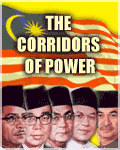In the aftermath of May 5th (part 10) (UPDATED with Chinese Translation)

Out of the 89 parliamentary seats that Pakatan Rakyat won, 53 are non-Malay/Muslim seats while only 36 can be said to be Malay/Muslim-majority seats. Umno, however, won 88 seats just by itself (almost the same as for DAP, PKR and PAS combined). Then there were another 12 non-Malay/Muslim seats with 33 from the native areas in East Malaysia.
THE CORRIDORS OF POWER
Raja Petra Kamarudin
Okay, let’s say Pakatan Rakyat won or wins the general election. Then let’s say Pakatan Rakyat does what it promises to do: it cancels the citizenship of 1.5 million ‘illegal’ citizens, mostly from East Malaysia, and kicks these people out of the country. Then Pakatan Rakyat ends the gerrymandering and, like some countries, passes a law so that the variance between seats is, say, within plus-minus 20%.
Can this be done?
Unfortunately it can’t. Currently, Sabah and Sarawak control 25% of the seats in Parliament even though it has about 19-20% of the population of Malaysia. And if you cancel the citizenship of one million or 1.5 million citizens, it would be even less than 20%, maybe just 15-16%. However, they will still control 25% of the seats in Parliament.
Hence, due to the agreement, it would be impossible to implement the plus-minus 20% variance between seats since, if you do this, you will then create more seats in West Malaysia and thus you will have to correspondingly increase the number of seats in East Malaysia to ensure that you maintain their 25% share of the seats.
And this would make it worse. The variance, because of East Malaysia, would get wider and you actually increase more seats in Barisan Nasional’s ‘fixed deposit’ region. For every three seats you increase in West Malaysia, you need to increase one more seat in East Malaysia.
What will happen in the end is: the seats will be divided into three categories. For the urban areas the seats may be, say, 80,000-120,000 voters (roughly 20% or so variance calculated on 100,000 voters per seat). For the semi-urban areas they may be 50,000-79,000 voters (roughly 20% or so variance calculated on 65,000 voters per seat). And for the rural areas they may be 30,000-49,000 voters (roughly 20% or so variance calculated on 40,000 voters per seat).
And after you redraw the election boundaries and increase the number of seats, you will end up creating more seats in the rural areas and East Malaysia, which can only work to Barisan Nasional’s favour. Furthermore, you need a two-thirds majority in Parliament to do this and you are never going to see a two-thirds majority for either Barisan Nasional or Pakatan Rakayat for a long time to come. The days of two-thirds majorities are gone.
But will Pakatan Rakyat support whatever proposal is tabled by Barisan Nasional? Certainly not, because whatever proposal Barisan Nasional tables will certainly be in its favour. And vice versa for Pakatan Rakyat if it happens to be in power: because whatever proposal Pakatan Rakyat tables will also be in its favour.
And that would mean Pakatan Rakyat’s supporters would all be lumped in the urban and semi-urban areas while Barisan Nasional’s supporters would be spread out in the rural areas and in East Malaysia. And this would also mean that Barisan Nasional could still stay in power with less than 50% of the popular votes while Pakatan Rakyat cannot get into power even with 55% of the popular votes.
Now, what was the strategy for both Barisan Nasional and Pakatan Rakyat in the recent general election on Sunday, 5th May 2013? I am not sure what Pakatan Rakyat’s strategy was but I think it was mainly to get the crowd.
And this they did.
Barisan Nasional, however, had a more devious strategy (devious only if you look at it through the eyes of an opposition supporter but clever if through the eyes of Machiavelli). Barisan Nasional’s strategy was to turn Pakatan Rakyat into a Chinese-dominated coalition and Barisan Nasional into a Malay-dominated opposition.
And this they did.
Out of the 89 parliamentary seats that Pakatan Rakyat won, 53 are non-Malay/Muslim seats while only 36 can be said to be Malay/Muslim-majority seats. Umno, however, won 88 seats just by itself (almost the same as for DAP, PKR and PAS combined). Then there were another 12 non-Malay/Muslim seats with 33 from the native areas in East Malaysia.
Without the MCA/MIC/Gerakan seats included, Umno and the ‘natives’ won 121 seats in Parliament — enough to form the government even without the help of MCA, MIC and Gerakan.
Umno intentionally wanted Pakatan Rakyat to appear Chinese and less multi-racial. They also wanted the Malays in Pakatan Rakyat to appear like ‘tools’ of the Chinese. And to do this they need to play the race card — which they are currently doing.
Can you now understand the reason for this sudden surge in Chinese-bashing? It is all part of the plan to make Pakatan Rakyat appear Chinese. And the Chinese supporters of Pakatan Rakyat are not helping much either. The more Malay-bashing you indulge in, the more you strengthen Umno’s strategy.



TO BE CONTINUED
***********************
5月5之後(十)
在民聯勝出的89個議席裏,有53個是非馬來人區而另36個則馬來人選區。相比起來,囯陣的巫統所贏得的88個選區(幾乎和民聯三黨的總數一樣)都是馬來人區。他們只有12個非馬來人選區,其他的33個則來自東馬。
原文:Raja Petra Kamarudin
譯文:方宙
好,就讓我們儅民聯勝出好了,而且還落實了他們之前所答應的:他們把150万‘非法’公民的身份給收回來(多是東馬人)然後再把他們踢出我國國門。民聯過後再通過立法,把每個選區的選民數訂位彼此的差別不可多過20%,徹底地結束了‘不均勻選民分gerrymandering’。
但這真能做到嗎?
很不幸的,答案是不能。沙巴和砂勞越的人口雖然只是佔了大馬的19-20%,但他們卻牢控了25%的囯席。如果你再收回150万的公民權,那他們的人口將會降至15-16%,但仍然還是會掌控25%的囯席。
所以說,立法落實鉗制每個選區的選民數是行不通的,因爲有之前的協議給牽制著。如果你真的要這麽做的話,你會為西馬增加席位,但與此同時你還是得為東馬增加席位來保持他們的25%囯席率。
這只會把事情弄得更糟。選民數的差別會因爲東馬而變得更大,而你做的正是增加著囯陣的‘鉄票區’。你每在西馬增加一區,你也必須在東馬增加一區,情況是這樣子的:
選區將會被區分為三個類別:城市區將會有80000-120000選民(取100000為中間點,所以20%的差別是+/- 20000),半城鄉是50000-79000選民(65000為中間點),而鄉區則是30000-49000選民。
儅你從新規劃選區的界綫和增加選區數后,你會發現更多的鄉區和東馬選區會被規劃出來,那是對囯陣大大有利的。再者,你需要2/3多數席才能從新規劃選區,而在可見的將來我們是不會再見到2/3多數權的政府的出現;2/3多數權政府的日子已不再歸來了。
你認爲民聯會認同囯陣的獻議嗎?當然不會,囯陣搬上桌子的所有東西都是只有對囯陣有利而已。當然,如果民聯上臺的話他們也會這樣做:民聯搬上桌子的所有東西都是只是對民聯有利的。
這也代表民聯的支持者始終會聚集在城市區而囯陣的則分散在鄉區和東馬;這也代表囯陣只要靠少過50%的選票就能當選而民聯即使搬出55%的選票也未必能上位。
那現在,囯陣和民聯在過去的5月5大選裏採取了什麽策略呢?我不能很確鑿地知道民聯的,但我猜他們是想得到大衆的支持。
他們確實達到了。
囯陣在另一方面則使出了個更狡猾的計謀(反對黨支持者來看就是狡猾,但對马基亚维利來講則是聰明)。他們的策略是把民聯渲染為一個華人主導的政黨聯盟而自己則是由馬來人主導的。
他們確實做到了。
在民聯勝出的89個議席裏,有53個是非馬來人區而另36個則馬來人選區。相比起來,囯陣的巫統所贏得的88個選區(幾乎和民聯的總數一樣)都是馬來人區。他們只有12個非馬來人選區,其他的33個則來自東馬。
如果我們不要算馬華/囯大黨/民政黨的議席,單單巫統和‘土著’政黨就贏得了121個議席—-他們本身就足夠組織政府了。
巫統特意地把民聯油漆成‘很華人’而不是很‘多個種族’,他們也把民聯的馬來人弄得看起來已變成了華人的‘工具’。他們打的正是種族這張牌—-到現在爲止他們還是正在打著。
你現在明白爲何突然之間有這麽多針對華人的言論湧現了沒?這全是要民聯看起來‘很華人’的策略,而民聯華裔支持者的動作也正為這策略‘加分’:你越是發表干屌馬來人的言論,你越是陷入巫統的策略陷阱裏。
(敬請期待下一篇文章)

